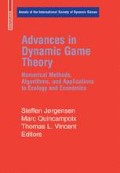Abstract
Previous work on the theory of continuous evolutionary games and adaptive dynamics has shown that a species can evolve to an evolutionarily stable minimum on a frequency-dependent adaptive landscape (e.g., Brown and Pavlovic [7], andAbrams etal. [3], [4]). While such stable minima are convergent stable, they can be invaded by rare alternative strategies. The significance of such stable minima for biology is that they produce “disruptive selection” which can potentially lead to speciation (Metz et al. [20], Geritz et al. [16], Cohen et al. [11], and Mitchell [21]. Previous analyses of Lotka-Volterra competition communities indicate that stable minima and speciation events are more likely to occur when the underlying resource distribution is broader than the resource utilization functions of the competing species. Here, I present an analysis based on a resource-consumer model which allows individuals to adaptively vary resource use as a function of competitor density and strategy. I show that habitat specialization, stable minima, community invasibility, and sympatric speciation are more likely when individuals are more efficient at converting resources into viable offspring. Conversely, factors that inhibit conversion efficiency inhibit speciation and promote competitive exclusion. This model suggests possible links between species diversity and factors influencing the resource conversion efficiency, such as climate, habitat fragmentation, and environmental toxins.
Access this chapter
Tax calculation will be finalised at checkout
Purchases are for personal use only
Preview
Unable to display preview. Download preview PDF.
References
Abrams, P.A. 1991. Life history and the relationship between food availability and foraging effort. Ecology. 72:1242–1252.
Abrams, P.A. 2003. Can adaptive evolution or behavior lead to diversification of traits determingin a trade-off between foraging gain and predation risk? Evol. Ecol. Res. 5:653–670.
Abrams, P.A., Y. Harada, and H. Matsuda. 1993. On the relationships between quantitative genetics and ESS models. Evolution. 47:982–985.
Abrams, P.A., H. Matsuda, and Y. Harada. 1993. Evolutionary unstable fitness maxima and stable fitness minima of continuous traits. Evol. Ecol. 7:465–487.
Brown, J.S. 1988. Patch use as an indicator of habitat preference, predation risk, and competition. Behavioral Ecology and Sociobiology. 22:37–47.
Brown, J.S. 1989. Desert rodent community structure: a test of four mechanisms of coexistence. Ecological Monographs 59:1–20.
Brown, J.S. and N.B. Pavlovic. 1992. Evolution in heterogeneous envioronments: Effects of migration on habitat specialization. Evol. Ecol. 6:360–382.
Brown, J.S. and T.L. Vincent. 1992. Organization of predator-prey communities as an evolutionary game. Evolution. 46:1269–1283.
Charhov, E.L. 1976. Optimal Foraging, the marginal value theorem. Theoretical Population Biol. 9: 129–136.
Christiansen, F.B. 1991. On conditions for evolutionary stability for a continuously varying character. Amer. Nat. 138:37–50.
Cohen, Y., T.L. Vincent, and J.S. Brown. 1999. A G-function approach to fitness minima, fitness maxima, evolutionarily stable strategies and adaptive landscapes. Evol. Ecol. Res. 1:923–942.
Diekmann, U. and M. Doebeli. 1999. On the origin of species by sympatric speciation. Nature 400:354–357.
Doebeli, M. and U. Dieckmann. 2000. Evolutionary branching and sympatric speciation caused by different types of ecological interactions. Amer. Nat. 156:S77–S101.
Eschel, I. 1983. Evolutionary and continuous stability. J. Theor. Biol. 103:99–111.
Geritz, S.A.H., E. Kisdi, G. Meszena, and J.A.J. Metz. 1998. Evolutionarily singular strategies and the adaptive growth and branching of the evolutionary tree. Evol. Ecol. 12:35–57.
Geritz, S.A.H., J.A.J. Metz, E. Kisdi, and G Meszena. 1997. The dynamics of adaptation and evolutionary branching. Phys. Rev. Lett. 78:2024–2027.
Jiang, Lin, and P.J. Morin. 2004. Temperature-dependent interactions explain unexpected responses to environmental warming in communities of competitors. J. Anim. Ecol. 73:560–576.
Kisdi, E. 1999. Evolutionary branching under asymmetric competition. J. Theor. Biol. 197:149–162.
Maynard Smith, J., and G.R. Price. 1973. The logic of animal conflict. Nature 246:15–18.
Metz, J.A.J., S.A.H. Geritz, G Meszena, F.J.A. Jacobs, and J.S. van Heerwaarden. 1996. pp. 183–231 in S.J. van Strien and S.M. Verduyn Lunel, eds. Stochastic and Spatial Structures of Dynamical Systems. North-Holland, Amsterdam.
Mitchell, W.A. 2000. Limits to species richness in a continuum of habitat heterogeneity: an ESS approach. Evol. Ecol. Res. 2:293–316.
Mitchell, W.A., Z. Abramsky, B.P. Kotler, B. Pinshow, and J.S. Brown. 1990. The effect of competition on foraging activity in desert rodents: theory and experiments. Ecology 71:844–854.
Mitchell, W.A. and W.P. Porter. 2001. Foraging games and species diversity. Annales Zoologici Fennici 38:89–98.
Rosenzweig, M.L. 1995. Species Diversity in Space and Time. Cambridge University Press, Cambridge.
Schluter, D. 2000. The Ecology of Adaptive Radiation. Oxford University Press. Oxford.
Stephens, D.W. and J.R. Krebs. 1986. Foraging Theory. Princeton University Press. Princeton, NJ.
Turchin, P. 2003. Complex Population Dynamics. Princeton University Press, Princeton, NJ.
Vincent, T.L., Y. Cohen, and J.S. Brown. 1993. Evolution via strategy dynamics. Theor. Pop. Biol. 44:149–176.
Author information
Authors and Affiliations
Editor information
Editors and Affiliations
Rights and permissions
Copyright information
© 2007 Birkhäuser Boston
About this chapter
Cite this chapter
Mitchell, W.A. (2007). Adaptive Dynamics, Resource Conversion Efficiency, and Species Diversity. In: Jørgensen, S., Quincampoix, M., Vincent, T.L. (eds) Advances in Dynamic Game Theory. Annals of the International Society of Dynamic Games, vol 9. Birkhäuser Boston. https://doi.org/10.1007/978-0-8176-4553-3_14
Download citation
DOI: https://doi.org/10.1007/978-0-8176-4553-3_14
Publisher Name: Birkhäuser Boston
Print ISBN: 978-0-8176-4399-7
Online ISBN: 978-0-8176-4553-3
eBook Packages: Mathematics and StatisticsMathematics and Statistics (R0)

